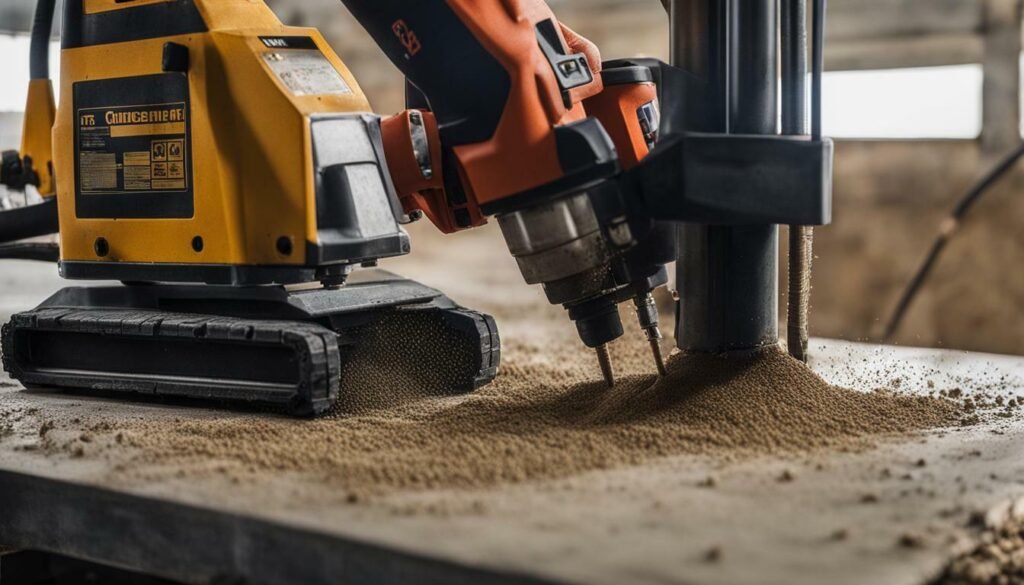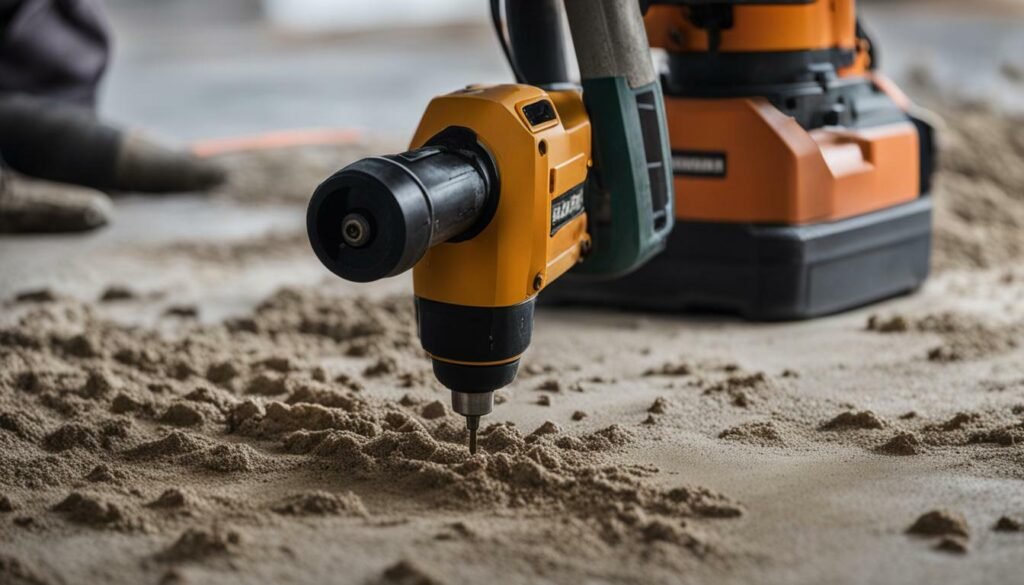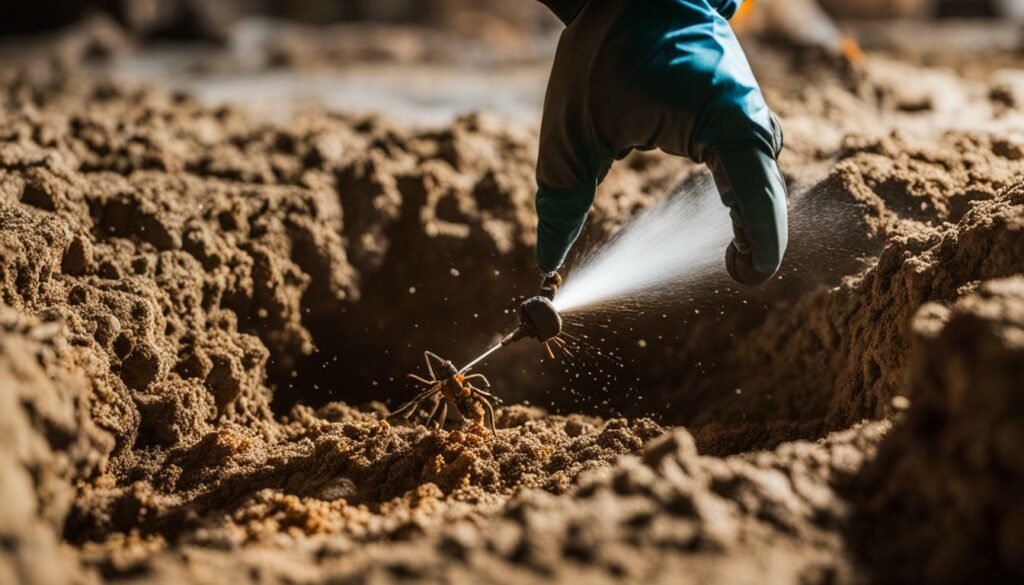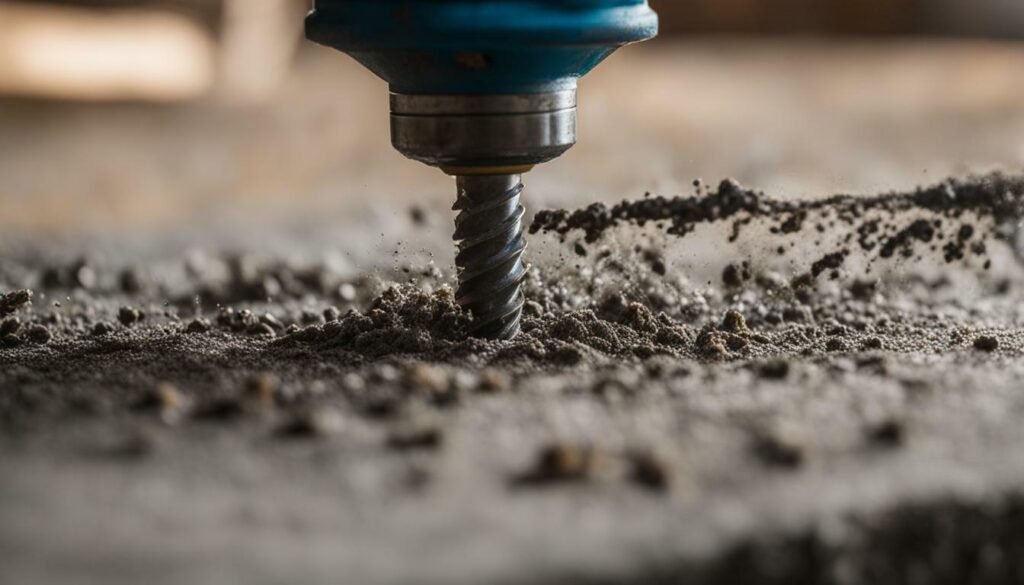Are you looking for an effective termite treatment method that can safeguard your home? Discover the power of drilling holes in concrete to control termite infestations in this comprehensive guide. Drilling holes in concrete is a proven and reliable technique that can keep your home safe from these destructive pests. By understanding the process and consulting with pest control specialists, you can effectively combat termite infestations and protect your property.
Key Takeaways:
- Drilling holes in concrete is an effective method for termite treatment.
- Consulting with pest control specialists is crucial before attempting this method.
- Accurate marking and using the appropriate drill and instrument are essential for success.
- Filling the holes with insecticide and sealing them with caulk is a necessary step.
- This method is particularly effective for wooden termites but can also be used for subterranean termites.
Understanding Termite Infestation: Drilling into the Problem
Before we delve into the effectiveness of drilling holes in concrete for termite treatment, let’s understand the nature of termite infestations and how they impact the structural integrity of buildings, especially concrete slabs. Termites are small, wood-destroying insects that feed on cellulose material, including wooden beams, furniture, and even books. Their silent nature and ability to cause extensive damage over time make them a serious threat to homes and other structures.
Termite infestations often go unnoticed until significant damage has already occurred. These pests can easily enter buildings through small cracks or gaps in the foundation, and once inside, they establish colonies and continue to feed on the cellulose-rich materials around them. Over time, this can weaken the structural integrity of the building, especially in concrete slabs that may be supporting heavy loads.
Drilling holes in concrete slabs and walls is a method commonly used to combat termite infestations. By strategically drilling holes into the affected areas, pest control specialists can gain access to the termite nests and apply insecticides directly, effectively eliminating the infestation. This method allows for targeted treatment and ensures that the insecticide reaches deep into the affected areas, where termites may be hiding.


It is important to note that while drilling holes in concrete may affect the appearance and structural integrity of the building, it is a necessary step to effectively control termites and prevent further damage. Before attempting this method, it is highly recommended to consult with pest control specialists who have the knowledge and experience to assess the severity of the infestation and determine the most appropriate course of action.
The Process: Drilling Holes and Applying Insecticide
Now that we know the importance of tackling termite infestations, let’s explore the process of termite treatment through drilling holes in concrete, a technique widely recognized for its effectiveness. This method involves drilling holes in the ground or wooden walls and pouring insecticide inside to prevent further infestations or eliminate existing nests.
The first step in the process is accurate marking. It is crucial to identify the specific areas where termite activity is present for targeted treatment. Once the areas are marked, the drilling begins using the appropriate drill and instrument. The size of the holes will depend on the extent of the infestation and the type of termite species being targeted.
After drilling the holes, the next step is to fill them with insecticide. This is a critical step as it ensures the insecticide reaches the termite colonies deep within the walls or ground. The type of insecticide used will vary depending on the pest control specialist’s recommendations and the specific requirements of the infestation.
Finally, the drilled holes need to be sealed with caulk to prevent any future termite infestations. This step is essential as it closes off the access points and ensures the effectiveness of the treatment over time. Sealing the holes also helps to maintain the structural integrity of the building.


In summary, drilling holes in concrete is a proven and cost-effective method for termite control. By following the process of accurate marking, drilling, insecticide application, and sealing, the technique effectively eliminates termite infestations. It is important to consult with pest control specialists to ensure the proper implementation of this method and to explore alternatives if necessary. With its reliability and widespread use, drilling holes in concrete remains a valuable approach to protecting homes from termite damage.
Consulting the Experts: Pest Control Specialists
When it comes to dealing with termite infestations and employing drilling holes in concrete as a control method, consulting pest control specialists is crucial for achieving the best outcomes. These professionals have the knowledge and expertise to accurately assess the situation and recommend the most effective treatment options.
Pest control specialists understand the behavior and habits of termites, allowing them to identify key areas of infestation. By partnering with these experts, you can ensure that the drilling process is done correctly, targeting the specific areas where termites are most likely to be present.
Additionally, pest control specialists can guide you in choosing the right drilling equipment and insecticides for your unique situation. They will ensure that all safety precautions are followed and that the treatment is conducted in a manner that minimizes any potential hazards to you or your property.
Why Choose Pest Control Specialists?
By consulting with pest control specialists, you are tapping into their years of experience and knowledge in the field of termite control. They stay up-to-date on the latest advancements in drilling techniques and can provide you with the most effective solutions.
Furthermore, pest control specialists can offer long-term prevention strategies to keep your home protected against future termite infestations. They can recommend regular inspections and maintenance practices that will help you maintain a termite-free environment.
Don’t underestimate the value of consulting pest control specialists when dealing with termite infestations and using drilling holes in concrete as a control method. Their expertise and guidance will ensure that your termite treatment is effective, safe, and reliable.


Table: Overview of Pest Control Specialist Services
| Services | Benefits |
|---|---|
| Termite inspections | Early detection of termite infestations |
| Drilling equipment and technique guidance | Ensure accurate drilling and optimal treatment |
| Selection of appropriate insecticides | Effective elimination of termites |
| Long-term prevention strategies | Maintain a termite-free environment |
Technique Matters: Accurate Marking and Instrumentation
To effectively control termites using the drilling holes technique, it is imperative to emphasize accurate marking and the use of appropriate instrumentation for efficient and precise drilling. This ensures that the drilled holes are strategically placed to target termite colonies and minimize damage to the surrounding area.
Accurate marking involves identifying the areas where termite activity is most prevalent. This can be determined through a thorough inspection of the property by a pest control specialist. By marking these specific areas, you can direct your drilling efforts towards the heart of the infestation.
The choice of instrumentation is also crucial in achieving successful termite control. High-quality drilling equipment, such as rotary hammers or core drills, should be used to ensure precise and clean holes. These tools provide the necessary power and stability to penetrate concrete surfaces effectively.
Furthermore, using the appropriate drill bits is essential. Carbide or diamond-tipped drill bits are commonly recommended for their durability and ability to cut through concrete with ease. They create clean holes without causing unnecessary damage to the surrounding structure.
By prioritizing accurate marking and the use of suitable instrumentation, you can significantly improve the effectiveness of termite treatment through drilling. This technique offers a targeted and efficient approach to eliminate termites and protect your property from further infestation.


Table 1: Recommended Equipment for Drilling Holes in Concrete
| Equipment | Description |
|---|---|
| Rotary Hammer | A powerful drill that combines a hammering action with rotation. Ideal for drilling holes in concrete. |
| Core Drill | A specialized drill used for creating larger and deeper holes in concrete. Requires a stable base or stand for support. |
| Carbide Drill Bits | Drill bits with carbide tips for enhanced durability and precision when drilling through concrete surfaces. |
| Diamond-tipped Drill Bits | Drill bits with diamond-coated tips that offer superior cutting power and longevity. Ideal for drilling through tough materials like reinforced concrete. |
“Accurate marking and precise instrumentation are key factors in the success of termite treatment through drilling. By carefully identifying the infestation areas and using the right tools, you can effectively eradicate termites and safeguard your property.” – Pest Control Specialist
Filling the Holes: Insecticide Application
Once the holes have been drilled, the next crucial step in the termite treatment process is filling them with the appropriate insecticide to effectively eliminate the pests. This step is essential to ensure that the termites are exposed to the insecticide, preventing further infestations and eliminating existing colonies.
When choosing an insecticide for termite control with concrete drilling, it is important to select a product specifically formulated for this purpose. These insecticides are designed to penetrate the soil or wood, reaching the termites and effectively eliminating them. Consulting with pest control specialists can help determine the most suitable insecticide for your specific termite infestation.
Proper application of the insecticide is crucial to ensure its effectiveness. This involves carefully pouring the insecticide into the drilled holes, making sure to reach the desired depth. It is recommended to follow the manufacturer’s instructions for the amount of insecticide to use and the frequency of application. Expert guidance can help ensure that the insecticide is applied correctly and in the appropriate areas.
| Insecticide Application Tips: |
|---|
| Wear protective gear, such as gloves and goggles, when handling and applying the insecticide. |
| Use a funnel or sprayer to accurately pour the insecticide into the drilled holes. |
| Apply the insecticide evenly and thoroughly, ensuring complete coverage. |
| Monitor the treated areas regularly for any signs of termite activity and reapply the insecticide if necessary. |
Expert Perspective:
“Proper insecticide application is crucial in achieving successful termite control with concrete drilling. It is important to choose an insecticide that is specifically designed for this method and follow the recommended application guidelines. Seeking the assistance of pest control specialists ensures that the insecticide is applied accurately and efficiently, maximizing its effectiveness in eliminating termites.” – Pest Control Specialist


By filling the drilled holes with the appropriate insecticide, you can effectively target and eliminate termites, preventing further damage to your property. This method has been proven to be highly successful for termite control, particularly in addressing infestations caused by wooden termites. However, it is important to note that concrete drilling can also be used to control subterranean termites by targeting their base of operation within the house.
While drilling holes in concrete may have an impact on the appearance and structural integrity of the building, it remains a cost-effective and widely used method for termite control. It is important to consult with pest control specialists who can provide expert guidance throughout the process to ensure optimal results. Additionally, alternatives such as chemical fumigation and professional baiting systems are available for termite treatment, but drilling holes with insecticide application has proven to be an effective and reliable approach.
Remember, effective termite treatment is essential in protecting your home from potential structural damage caused by these destructive pests. By considering the process of drilling holes and filling them with the appropriate insecticide, you can effectively control termite infestations and safeguard your property.
Sealing the Deal: Using Caulk to Seal Drilled Holes
To ensure long-term termite prevention, it is vital to properly seal the drilled holes with caulk, creating a barrier that deters termites from re-infesting the treated areas. Sealing the holes not only helps to maintain the integrity of the concrete but also prevents termites from finding their way back into your home. By effectively sealing the drilled holes, you are taking an important step in safeguarding your property against future termite infestations.
When it comes to selecting the right caulk for sealing drilled holes, it is essential to choose one that is specifically designed for termite prevention. Look for a caulk product that offers long-lasting protection and is resistant to moisture, as termites are attracted to damp environments. Applying a generous amount of caulk to the drilled holes ensures that no gaps or openings are left behind, leaving no room for termites to enter.


Remember to follow the manufacturer’s instructions when applying the caulk and allow it ample time to dry and cure. Regularly inspect the sealed holes for any signs of deterioration or damage and promptly reapply caulk as needed to maintain the effectiveness of the termite prevention barrier.
Benefits of Sealing Drilled Holes
Properly sealing drilled holes offers several key benefits in termite prevention. Firstly, it acts as a physical deterrent, making it difficult for termites to access the treated areas. Secondly, it helps to preserve the structural integrity of the concrete, ensuring that it remains strong and resilient over time. Lastly, sealing the holes creates a visual barrier, providing peace of mind and assurance that your home is protected against potential termite infestations.
| Benefits of Sealing Drilled Holes |
|---|
| Acts as a physical deterrent |
| Preserves structural integrity |
| Provides visual reassurance |
By incorporating the step of sealing drilled holes into your termite prevention strategy, you can effectively enhance the overall effectiveness of termite treatment through concrete drilling. Be sure to consult with pest control specialists who can guide you through the proper techniques and provide expert advice on the best caulk products to use for optimal results. With careful attention to detail and proactive prevention measures, you can keep your home termite-free and protected for the long term.
Targeting Wooden Termites: A Specialized Approach
Concrete drilling for termite treatment offers numerous benefits, particularly when it comes to targeting wooden termites that can cause significant damage to the structure of your home. By drilling holes in the affected areas, you can effectively eliminate termite infestations and prevent further damage. This method not only helps in eradicating termites but also serves as a preventive measure against future infestations.
One of the main advantages of using concrete drilling for termite control is its accuracy in targeting the source of the problem. By drilling directly into the wooden areas where termites are active, you can deliver the insecticide directly into their nests, effectively eliminating them. This precise approach ensures that the treatment reaches the root cause of the infestation, providing long-lasting protection for your property.
Another benefit of concrete drilling is its cost-effectiveness. Compared to alternative methods such as chemical fumigation or professional baiting systems, drilling holes and applying insecticide is a more affordable option. This makes it an attractive choice for homeowners looking for an effective yet budget-friendly solution to their termite problems.
| Benefits of Concrete Drilling for Termite Treatment |
|---|
| Accurate targeting of wooden termites |
| Effective elimination of termite infestations |
| Prevents further damage to the structure of your home |
| Cost-effective compared to other methods |
It is important to note that while concrete drilling is effective for wooden termites, it may not be suitable for all types of termite infestations. Subterranean termites, for example, require a different approach where drilling into the base of the house is necessary. Consulting with pest control specialists is crucial to assess the type of infestation and determine the most appropriate treatment method.
Concrete drilling for termite treatment is a reliable and widely used technique that offers numerous benefits for homeowners. It not only effectively targets wooden termites but also provides long-lasting protection against future infestations. By consulting with experts and following the proper procedures, you can successfully eliminate termites and safeguard your home from further damage.


Beyond Wood: Drilling into Subterranean Termites
Concrete drilling as a termite control method extends beyond wooden termites and can effectively combat infestations caused by subterranean termites by drilling into the base of your house. This specialized approach targets the underground nests of these destructive pests, ensuring comprehensive termite control.
When dealing with subterranean termites, it is crucial to identify the areas where they are entering your home. These termites typically build their nests in the soil and create mud tubes or tunnels to access food sources above ground. By strategically drilling into the base of your house, you can intercept these tunnels and treat them directly with insecticide.
Drilling into the base of your house requires precision and careful consideration. Pest control specialists are equipped with the knowledge and experience to determine the optimal locations for drilling and ensure effective treatment. They will use specialized equipment and techniques to access the subterranean termite nests without causing damage to your home’s foundation.
“By strategically drilling into the base of your house, you can intercept these tunnels and treat them directly with insecticide.”
Once the holes are drilled, a powerful insecticide is injected into the tunnels, targeting the subterranean termites and eliminating them at the source. The insecticide will spread throughout the underground network, preventing further infestations and protecting your home from future termite damage.
Remember that termite infestations can cause significant damage to your property if left untreated. Consulting pest control specialists who are experienced in concrete drilling for termite control is essential to ensure the effectiveness of the treatment and the long-term protection of your home.


| Benefits of Concrete Drilling for Subterranean Termites: |
|---|
| Targets underground termite nests directly |
| Prevents further infestations by eliminating termites at the source |
| Preserves the structural integrity of your home |
| Cost-effective compared to alternative treatment methods |
Conclusion
Termite treatment drilling holes in concrete is a cost-effective and widely used method for controlling termite infestations, offering homeowners a reliable solution to keep their properties safe and secure. By drilling holes in the ground or wooden walls and applying insecticide, this technique prevents further infestations and eliminates existing nests.
While drilling holes may affect the appearance and structural integrity of the building, it remains a popular choice due to its effectiveness. Before attempting this method, it is highly recommended to consult with pest control specialists who can provide expert guidance and ensure optimal results.
The drilling process involves accurate marking, using the appropriate drill and instrument, and filling the holes with the right insecticide. This targeted approach is particularly effective for wooden termites, but it can also be utilized to control subterranean termites by drilling into the base of the house.
Alternatives to drilling holes include chemical fumigation and professional baiting systems. However, drilling holes in concrete is a widely preferred method due to its cost-effectiveness and reliability. It offers homeowners peace of mind by providing a long-lasting solution to protect their properties from costly termite damage.
FAQ
Q: Is drilling holes in concrete an effective method for termite treatment?
A: Yes, drilling holes in concrete is an effective method for termite treatment. It involves drilling holes in the ground or wooden walls and pouring insecticide inside to prevent further infestations or eliminate existing nests.
Q: Will drilling holes in concrete affect the appearance and structural integrity of the building?
A: Yes, drilling holes may affect the appearance and structural integrity of the building. However, it is a popular and effective way to control termites.
Q: Should I consult with pest control specialists before attempting termite treatment through drilling holes in concrete?
A: Yes, it is recommended to consult with pest control specialists before attempting termite treatment through drilling holes in concrete. They can provide guidance and ensure optimal results.
Q: What is the process of drilling holes in concrete for termite treatment?
A: The process involves accurate marking, using the appropriate drill and instrument, filling the holes with insecticide, and sealing them with caulk.
Q: Can drilling holes in concrete be used for subterranean termites?
A: Yes, drilling into the base of the house can be used to control subterranean termites in addition to wooden termites.
Q: Are there alternatives to drilling holes in concrete for termite treatment?
A: Yes, alternatives include chemical fumigation and professional baiting systems. However, drilling holes in concrete is a cost-effective and widely used method for termite control.
Source Links
- https://pests.guru/termites/control/treatment/methods/drill-holes.html
- https://www.mothernaturesinc.com/article/effective-termite-treatment-drill-holes-in-the-foundation
- https://www.mugabugpestcontrol.com/subterranean-termite-treatments/
Your Expert in Animal Control and Extermination. Trust our experience for humane, effective pest management, protecting your property and ensuring peace of mind with Michael S.





